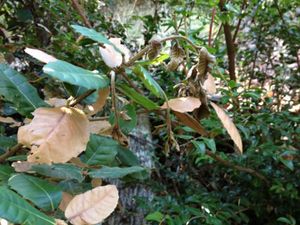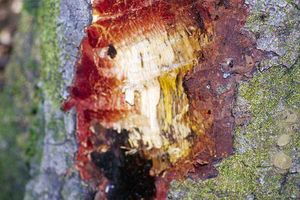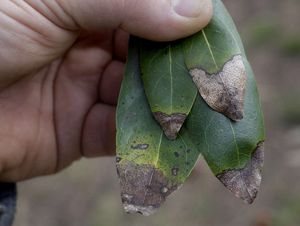Sudden Oak Death (SOD)
An environmental summary created by the ENVS 560/L Watershed Systems class at CSUMB.

This page discusses sudden oak death (SOD), an oak tree disease caused by the plant pathogen (Phytophthora ramorum). Supplemental information about Invasive Fungi of California's Central Coast Region can be found here.
Contents
Summary

Sudden oak death (SOD) is a non-native forest disease that is believed to have originated in Asia and spread via international nursery trade. [1] The name of the disease is rooted in its initial discovery in 1995 when researchers in Marin County, California observed widespread rapid oak mortality.[2][3] Researchers later determined that SOD results from infection by Phytophthora ramorum, a type of water mold responsible for causing Ramorum Blight. [4]
P. ramorum affects many plant species. It can infect and cause mortality in coast live oak (Quercus agrifolia), California black oak (Quercus kelloggii), Shreve oak (Quercus parvula var. shrevei), canyon live oak (Quercus chrysolepis), and tanoak (Lithocarpus densiforus). Oak species vary in their susceptibility to P. ramorum infection. Tanoak and coast live oak have poor resistance to infection and experience high mortality rates.[5] Over 1 million trees have died due to SOD in Northern and Central California.[6]
P. ramorum can also cause twig and foliar diseases in species such as California Bay laurel (Umbellularia californica), Douglas-fir (Pseudotsuga menziesii), and coast redwood (Sequoia sempervirens). These species are often hosts of pathogen, primarily responsible for the pathogen's dispersal, but themselves do not die from the disease.
There is no known cure for SOD.[7] Current management efforts are focused on curtailing the spread of P. Ramorum from infected to unaffected regions.
Symptoms
Foliar Blight

Foliar Blight and branch die-back indicators of infection. These symptoms typically occur 2 to 4 weeks after infection. One symptom common in the early stage of infection is the wilting of apical shoots (commonly referred to as "Shepherd's Crooks"). Other foliage-related symptoms include brown blotches on leaves, rapid browning leaves throughout the crown, tip droop and die-back, and branch die-back caused by branch cankers.[8][9]
Trees infected by P. ramorum do not die immediately after these symptoms appear. The latency period between foliar blight and death is around two years.[10]
Cankers and "bleeding"

Cankers are brown, water-filled abrasions that form on the bark of infected trees. Frequently, these legions can penetrate into the xylem. Cankers can damage the tree bark, leading to fracturing of bark and tree girdling. These symptoms can accelerate declines in tree health and expedite tree death.[11]
Cankerous regions release viscous sap. This black to amber hued fluid seeps out in a process known as "bleeding". [12]
P. ramorum Hosts in California

While all hosts species can be infected by SOD, not all species die from infection. Several species act as carriers that can potentially transfer the pathogen to sensitive species. Several hosts of P. ramorum have been identified worldwide.[13] The known hosts in California[14] include:
Oak species
- Coast live oak (Q. agrifolia)
- California black oak (Q. kelloggii)
- Shreve's oak (Q. parvula var. shrevei)
- Canyon live oak (Q. chrysolepsis)
- Tanoak (Lithocarpus densiflora)
Non-oak species
- Madrone (Arbutus menziesii)
- Evergreen huckleberry (Vaccinium ovatum)
- Manzanita (Arctostaphylos spp.)
- Ornamental rhododendron (Rhododendron spp.)
- Bay laurel (U. californica)
- Big leaf maple (Acer macrophyllum)
- Toyon (Heteromeles arbutifolia)
- Salmon berry (Rubus spectabilis)
- California buckeye (Aesculus californica)
- Coffeeberry (Rhamnus californica)
- Cascara (Rhamnus purshiana)
- California hazelnut (Corylus cornuta)
- Honeysuckle (Lonicera hispidula)
- Viburnum (Viburnum spp.)
- Poison oak (Toxicodendron diversilobum)
- Western starflower (Trientalis latifolia)
- Coast redwood (Sequoia sempervirens)
- Douglas fir (Pseudotsuga menziesii)
Prevalence in Central California

While SOD was first found in central California[15], the disease has not spread to every county in the central coast. A 2011 study of the distribution of SOD in California revealed that Santa Cruz and Monterey were the only central coast counties with confirmed cases of SOD.[16] However, a 2016 distribution map by OakMapper suggests that SOD might be more widespread throughout the central coast.
Impacts and concerns
SOD causes marked declines in oak woodland populations. It is estimated to double and quadruple the mortality of coast live oak and tanoak, respectively.[17]
Ecology
Declines in oak woodlands could have cascading ecological impacts. Oak woodlands serve as habitat several organisms, including federally protected species like the California Tiger Salamander and California Red-legged frog[18]. Reductions in oak populations could result in less nesting grounds for birds and negatively impact nesting success. The amount of acorns produced would also drop, resulting in marked declines in a food source some vertebrate populations may depend on.[19]
Spread of SOD
Particularly concerning is the potential spreading of SOD from infected regions to unaffected regions. Laboratory experiments have revealed that oaks species on the eastern coast of the United States can be infected by SOD.[20] These species include northern red oak (Quercus rubra), mountain laurel (Kalmia latifolia), sugar maple (Acer saccharum), black walnut (Juglans nigra), white oak (Quercus alba), and chestnut oak (Q. prinus).[21]
Nursery Industry
Commerce of nursery and ornamental plants has changed in light of research suggesting that P. ramorum was introduced via nursery plant trade.[22] In California counties with known cases of SOD, hosts plants are thoroughly inspected before being transported out into unaffected regions.
However, the nursery industry remains as a potential vector for P. ramorum. Some nurseries use fungicides that eliminate symptoms of SOD but not the pathogen itself. Additionally, initial stages of infection can present themselves with little or no easily observable symptoms. These plants might be incorrectly deemed as unaffected and could potentially spread P. ramorum[23].
Economic resources at risk
SOD poses a threat to various forest-related economic resources. Oak tree industries bring in revenue at both the state and federal level. California oak woodlands generate an estimated $50 million in revenue per year. Nationally, the red oak timber industry generates over $300 million. Mass die-offs of oak trees spurred by SOD could have negative impacts on these sources of revenue.[24]
Other forest related industries could also be affected by SOD. The Christmas tree industry, which had a wholesale value of $530 million in 2003. Douglass-firs are a known host of P. ramorum; eradication of infected douglass-firs could result in declines in Christmas tree revenue.[25]
Human impact
The California Oak Mortality Task Force provides guidelines on how anthropogenic spread of SOD can be reduced. These are:
- Stay out of infested wildlands during high risk times altogether.
- Don’t collect or transport host plant material from an infested or quarantined area.
- Avoid entering infested areas during wet conditions.
- Keep vehicles on paved and graveled surfaces when conditions are wet.
- Stay out of areas of wet soil and mud.
- If you do enter an infested area during wet conditions, check yourself, your pet(s), vehicle and equipment for accumulations of mud, soil, organic material, and detached plant leaves. Remove these accumulations before traveling to an area that is not infested.
- If you live in an area infested with P. ramorum, chances are some of your belongings may be contaminated by the pathogen. If you travel to an area that does not have the disease, be sure that the belongings that you take with you are clean – shoes, bicycles, pets, vehicle, etc.
Additional sanitation instructions for working in infested areas are also provided.
Management
Current management practices as outlined by the University of California suggest a three-pronged approach: nursery management and monitoring, spread reduction efforts, and fungicides.
Nursery management
In nurseries concerned with SOD spread, the main priority should be preventing the introduction of the pathogen. Careful inspection of incoming stock can help minimize the risk of introduction. Auxiliary efforts at disease prevention are careful monitoring of stock stored outdoors and withholding the use of fungicide when monitoring the infection status of plants.
Extra precautions should be taken if nurseries are located near SOD hosts or in regions with SOD presence. These include doing things like:
- Monitoring nearby host plants for signs of disease
- Building berms to prevent the movement of soil and water into the nursery
- If using irrigation water pumped from nearby streams and ponds, periodically checking it for contamination of P. ramorum.
Spread reduction efforts
Certain practices and monitoring efforts around infected areas can reduce SOD spread. Minimizing the period foilage is wet can reduce the spread of SOD, as wet conditions are conducive for P. ramorum spread. Irrigation systems and sources should be carefully checked for any potential leaks, cracks, or presence of P. ramorum. Effort should be made to avoid mixing in soil or plant material from infected sites to uninfected sites. Tools should be carefully disinfected if they come in contact with infected soil or plants.
Fungicides
Fungicides are a preventative measure as no current fungicide can eliminate P. ramorum infections. However, it is advised to use fungicides only once all other management methods have been exhausted. Fungicides frequently mask SOD symptoms and make detection of the disease difficult.
Regulation
Federal
The USDA Animal and Plant Health Inspection Service (USDA-APHIS) develops and mandates federal regulations regarding P. ramorum. Additionally, USDA-APHIS determines the quarantine status of P. ramorum along the western coast.[26]
Several regulations regarding the movement of infected plants and hosts, quarantined and regulated areas, inspections, and nursery stock exist. These regulations are found under US Code of Federal Regulation, Title 7 (Agriculture), Part 301, Subpart Phytophthora Ramorum.[27]
In California
In California, the California Department of Food and Agriculture sets a statewide quarantine policy that interlocks with existing federal regulation. More information is available on the CDFA website.
Research
Ongoing
Current SOD research efforts are centered on better understanding how the disease spreads. These studies have the potential to improve management efforts in regions with and susceptible to SOD. Some research efforts are focused on monitoring the spread of SOD. Researchers from UC Berkeley have determined that SOD is spreading southward; moreover, it appears that recent increases in rainfall are propelling the expansion of the disease's range [28] Recent studies on incorporating predictive models to determine the spread of SOD have yielded promising results. These predictive models could be useful in early detection of SOD epidemics.[29]
Future Directions
Finding a cure or way to slow down the effects of SOD are areas of future research. Researchers in UC Berkeley are currently exploring chemical treatments to "immunize" healthy trees. One such compound class is copper sulfate sprays which will be tested on healthy coast live oaks. Another proposed chemical compound is a type of inoculation that would attack the pathogen systematically and help elongate the lifespan of infected trees.[30]
References
- ↑ US National Park Service: Redwood
- ↑ US National Park Service: Point Reyes
- ↑ (USDA) Department of Agriculture (US). 2003. Sudden Oak Death (SOD). UPlant Materials Technical Note. Montana: USDA. Available from: Technical Note Plant Materials MT-44
- ↑ California Oak Mortality Task Force
- ↑ UC Riverside Center for Invasive Species Research
- ↑ UC Riverside Center for Invasive Species Research
- ↑ California Oak Mortality Task Force
- ↑ UC Berkeley Forest Pathology and Mycology Laboratory
- ↑ Sentinel Plant Network
- ↑ California Oak Mortality Task Force
- ↑ Garbelotto M. and Hayden KJ. 2012. Sudden Oak Death: Interactions of the Exotic Oomycete Phytophthora ramorum with Naïve North American Hosts. Eukaryotic Cell: 11(11):1313–1323.
- ↑ Garbelotto M. and Hayden KJ. 2012. Sudden Oak Death: Interactions of the Exotic Oomycete Phytophthora ramorum with Naïve North American Hosts. Eukaryotic Cell: 11(11):1313–1323.
- ↑ California Oak Mortality Task Force
- ↑ Rizzo DM. 2003. Sudden Oak Death: host plants in forest ecosystems in California and Oregon. In: Proceedings of sudden oak death online symposium. American Phytopathological Society, http://www. apsnet. org/online/SOD
- ↑ Garbelotto M, Svihra P, Rizzo D. 2001. New pests and diseases: Sudden oak death syndrome fells 3 oak species. California agriculture 55(1):9–19.
- ↑ UC Riverside Center for Invasive Species Research
- ↑ Rizzo DM, Garbelotto M. 2003. Sudden oak death: endangering California and Oregon forest ecosystems. Frontiers in Ecology and the Environment 1(4):197–204.
- ↑ University of California Oak Woodland Management
- ↑ Rizzo DM, Garbelotto M. 2003. Sudden oak death: endangering California and Oregon forest ecosystems. Frontiers in Ecology and the Environment 1(4):197–204.
- ↑ Rizzo DM, Garbelotto M. 2003. Sudden oak death: endangering California and Oregon forest ecosystems. Frontiers in Ecology and the Environment 1(4):197–204.
- ↑ Don't Move Firewood
- ↑ University of Florida
- ↑ University of California Agriculture and Natural Resources
- ↑ (USDA) Department of Agriculture (US). 2010. Sudden Oak Death and Phytophthora ramorum: A Summary of the Literature. General Technical Report. Albany (CA): USDA. Available from: General Technical Report PSW-GTR-234
- ↑ (USDA) Department of Agriculture (US). 2010. Sudden Oak Death and Phytophthora ramorum: A Summary of the Literature. General Technical Report. Albany (CA): USDA. Available from: General Technical Report PSW-GTR-234
- ↑ California Oak Mortality Task Force
- ↑ US Government Publishing Office
- ↑ The Daily Californian
- ↑ Cunniffe NJ, Cobb RC, Meentemeyer RK, Rizzo DM, Gilligan CA. 2016. Modeling when, where, and how to manage a forest epidemic, motivated by sudden oak death in California. Proceedings of the National Academy of Sciences: 5640–5645.
- ↑ UC Berkeley Forest Pathology and Mycology Laboratory
Links
Disclaimer
This page may contain student work completed as part of assigned coursework. It may not be accurate. It does not necessarily reflect the opinion or policy of CSUMB, its staff, or students.